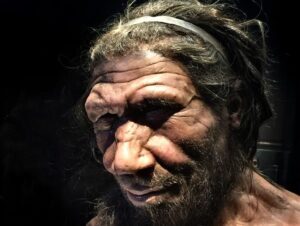
Institut Català de Paleontologia Miquel Crusafont—Neanderthals emerged around 250.000 years ago from European populations—referred to as “pre-Neanderthals”—which inhabited the Eurasian continent between 500.000 and 250.000 years ago. It was long believed that no significant changes occurred throughout the evolution of Neanderthals, yet recent paleogenetic research based on DNA samples extracted from fossils revealed the existence of a drastic genetic diversity loss event between early Neanderthals (or ancient Neanderthals) and later ones (also referred to as “classic” Neanderthals). Technically known as a “bottleneck”, this genetic loss is frequently the consequence of a reduction in the number of individuals of a population. Paleogenetic data indicate that the decline in genetic variation took place approximately 110,000 years ago.
The presence of an earlier bottleneck event related to the origin of the Neanderthal lineage was also a widespread assumption among the scientific community. As such, all hypotheses formulated thus far were based on the idea that the earliest Neanderthals exhibited lower genetic diversity than their pre-Neanderthal ancestors, as consequence of a bottleneck event. However, the existence of a bottleneck at the origin of the Neanderthals has not been confirmed yet through paleogenetic data, mainly due to the lack of genetic sequences old enough to record the event and needed for ancient DNA studies.
In a study* led by Alessandro Urciuoli (Institut Català de Paleontologia Miquel Crusafont, Universitat Autònoma de Barcelona) and Mercedes Conde-Valverde (Cátedra de Otoacústica Evolutiva de HM Hospitales y la Universidad de Alcalá), researchers measured the morphological diversity in the structure of the inner ear responsible for our sense of balance: the semicircular canals. It is widely accepted that results obtained from studying the morphological diversity of the semicircular canals are comparable to those obtained through DNA comparisons.
___________________________

TAKE A GLORIOUSLY SCENIC WALKING JOURNEY ON ANCIENT ETRUSCAN PATHS FOR THE EXPERIENCE OF A LIFETIME!
___________________________
The study focused on two exceptional collections of fossil humans: one from the Sima de los Huesos site of Atapuerca (Burgos, Spain), dated to 430,000 years old, which constitutes the largest sample of pre-Neanderthals available in the fossil record; and another from the Croatian site of Krapina, this representing the most complete collection of early Neanderthals and dated to approximately 130.000-120.000 years ago. The researchers calculated the amount of morphological diversity (i.e., disparity) of the semicircular canals of both samples, comparing them with each other and with a sample of classic Neanderthals of different ages and geographical origins.
The study’s findings reveal that the morphological diversity of the semicircular canals of classic Neanderthals is clearly lower than that of pre-Neanderthals and early Neanderthals, which aligns with previous paleogenetic results. Mercedes Conde-Valverde, co-author of the study, emphasized the importance of the analyzed sample: “By including fossils from a wide geographical and temporal range, we were able to capture a comprehensive picture of Neanderthal evolution. The reduction in diversity observed between the Krapina sample and classic Neanderthals is especially striking and clear, providing strong evidence of a bottleneck event.”
On the other hand, the results challenge the previously accepted idea that the origin of Neanderthals was associated with a significant loss of genetic diversity, prompting the need to propose new explanations for their origin. “We were surprised to find that the pre-Neanderthals from the Sima de los Huesos exhibited a level of morphological diversity similar to that of the early Neanderthals from Krapina,” commented Alessandro Urciuoli, lead author of the study. “This challenges the common assumption of a bottleneck event at the origin of the Neanderthal lineage,” the researcher stated.
Alessandro Urciuoli is a postdoctoral fellow at the University of Zurich (previously employed at the Universitat Autònoma de Barcelona as a Margarita Salas postdoctoral fellow) and associated researcher at the Institut Català de Paleontologia Miquel Crusafont; Mercedes Conde-Valverde is lecturer at the Universidad de Alcalá and director of the Cátedra de Otoacústica Evolutiva de HM Hospitales and the Universidad de Alcalá.
_____________________________
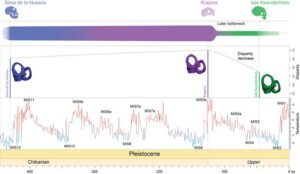
Schematic representation of the changes in morphological diversity along the evolutionary history of the Neanderthal clade. Sima de los Huesos and, particularly, Krapina populations show similarly large amounts of morphological variation, thus suggesting continuity during the Middle Pleistocene. Later, classic Neanderthals instead appear much less diverse, hence hinting for the presence of a drop in phenotypic variation right after the temperature maximum reached around 120.000 years ago, and at the beginning of the Last Glacial cycle. Alessandro Urciuoli (Institut Català de Paleontologia Miquel Crusafont)
________________________________
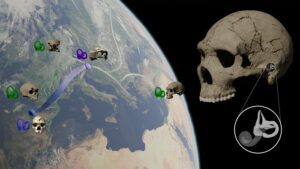
Artwork on the schematical representation of the distribuition of morphological variation of th inner ear along time in Neanderthals. Alessandro Urciuoli (Institut Català de Paleop
________________________________
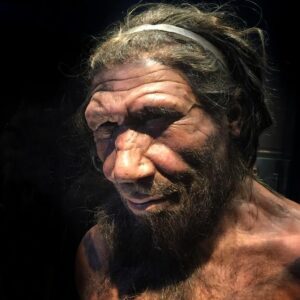
Life appearance reconstruction of a Neanderthal male at the Natural History Museum of London. (Photo: Allan Henderson under CC BY 2.0). Photo: Allan Henderson, under CC BY 2.0
________________________________
Article Source: Institut Català de Paleontologia Miquel Crusafont news release
*Semicircular canals shed light on bottleneck events in the evolution of the Neanderthal clade, Nature Communications, 20-Feb-2025. 10.1038/s41467-025-56155-8
________________________________
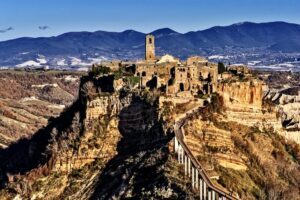
EXPLORE THE ANCIENT ETRUSCANS IN PERSON!
Experience a unique, up-close-and-personal hike among ancient hilltop towns in central Italy. You will walk the sensational countryside of the regions of Umbria and Tuscany, soaking in important sites attesting to the advanced Etruscan civilization, forerunners of the ancient Romans; imposing architectural and cultural remains of Medieval Italy; local food and drink; and perhaps best of all — spectacular scenic views! Join us in this collaborative event for the trip of a lifetime!


